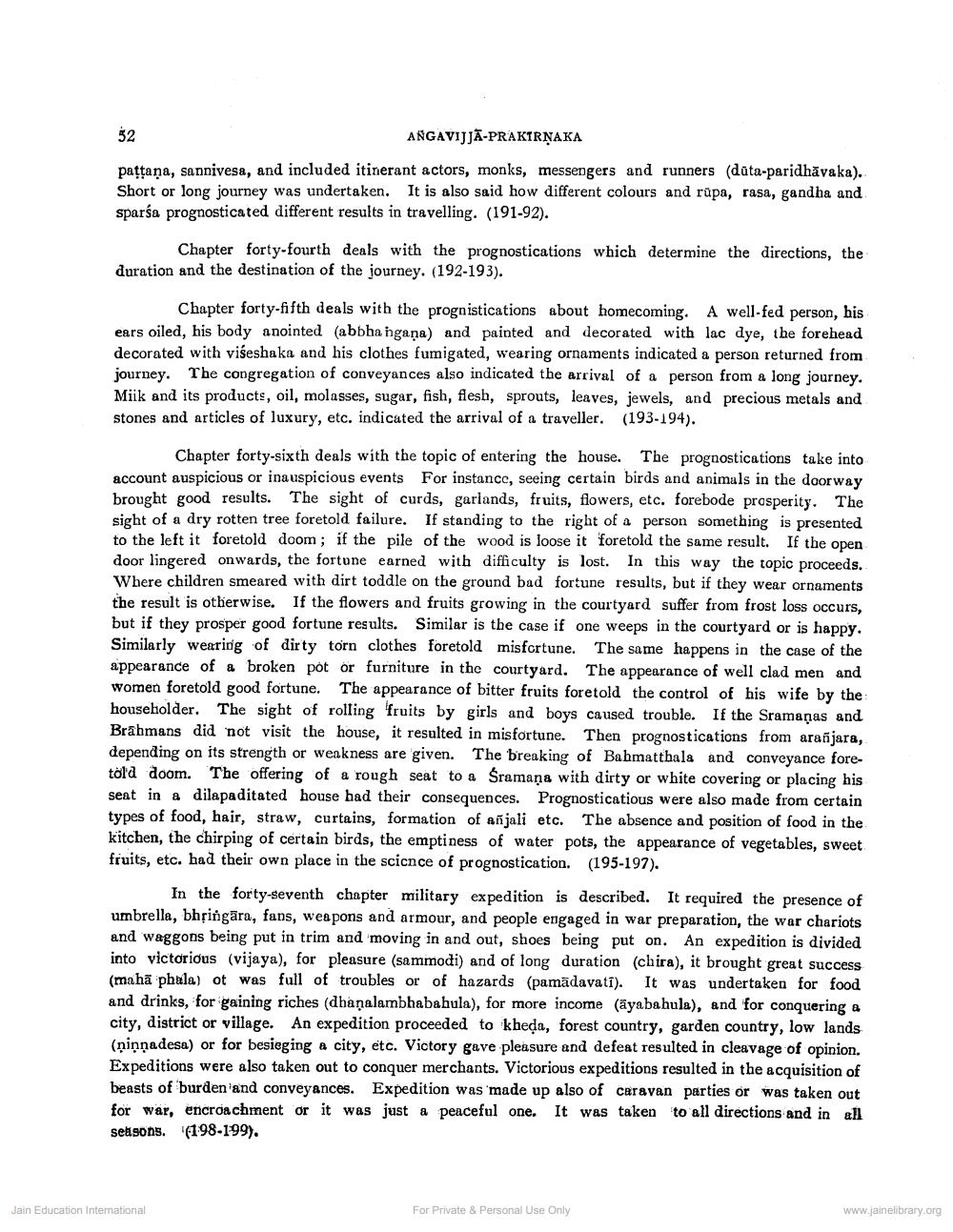________________
ANGAVIJJĀ-PRAKTRŅAKA
pațţaņa, sannivesa, and included itinerant actors, monks, messengers and runners (data-paridhāvaka). Short or long journey was undertaken. It is also said how different colours and rupa, rasa, gandha and sparśa prognosticated different results in travelling. (191-92).
Chapter forty-fourth deals with the prognostications which determine the directions, the duration and the destination of the journey. (192-193).
Chapter forty-fifth deals with the prognistications about homecoming. A well-fed person, his ears oiled, his body anointed (abbha ngana) and painted and decorated with lac dye, the forehead decorated with višeshaka and his clothes fumigated, wearing ornaments indicated a person returned from journey. The congregation of conveyances also indicated the arrival of a person from a long journey. Miik and its products, oil, molasses, sugar, fish, flesh, sprouts, leaves, jewels, and precious metals and stones and articles of luxury, etc. indicated the arrival of a traveller. (193-194).
Chapter forty-sixth deals with the topic of entering the house. The prognostications take into account auspicious or inauspicious events For instance, seeing certain birds and animuls in the doorway brought good results. The sight of curds, garlands, fruits, flowers, etc. forebode prosperity. The sight of a dry rotten tree foretold failure. If standing to the right of a person something is presented to the left it foretold doom; if the pile of the wood is loose it foretold the same result. If the open door lingered onwards, the fortune earned with difficulty is lost. In this way the topic proceeds. Where children smeared with dirt toddle on the ground bad fortune results, but if they wear ornaments the result is otherwise. If the flowers and fruits growing in the courtyard suffer from frost loss occurs, but if they prosper good fortune results. Similar is the case if one weeps in the courtyard or is happy. Similarly wearing of dirty torn clothes foretold misfortune. The same happens in the case of the appearance of a broken pot or furniture in the courtyard. The appearance of well clad men and women foretold good fortune. The appearance of bitter fruits foretold the control of his wife by the householder. The sight of rolling fruits by girls and boys caused trouble. If the Sramaņas and Brahmans did not visit the house, it resulted in misfortune. Then prognostications from arañjara, depending on its strength or weakness are given. The breaking of Bahmatthala and conveyance foretöld doom. The offering of a rough seat to a Sramana with dirty or white covering or placing his seat in a dilapaditated house had their consequences. Prognosticatious were also made from certain types of food, hair, straw, curtains, formation of anjali etc. The absence and position of food in the kitchen, the chirping of certain birds, the emptiness of water pots, the appearance of vegetables, sweet fruits, etc. had their own place in the science of prognostication. (195-197).
In the forty-seventh chapter military expedition is described. It required the presence of umbrella, bhringāra, fans, weapons and armour, and people engaged in war preparation, the war chariots and waggons being put in trim and moving in and out, shoes being put on. An expedition is divided into victorious (vijaya), for pleasure (sammodi) and of long duration (chira), it brought great success (mahā phala) ot was full of troubles or of hazards (pamādavati). It was undertaken for food and drinks, for gaining riches (dhaņalambhabahula), for more income (āyabahula), and for conquering a city, district or village. An expedition proceeded to kheda, forest country, garden country, low lands (ninnadesa) or for besieging a city, etc. Victory gave pleasure and defeat resulted in cleavage of opinion. Expeditions were also taken out to conquer merchants. Victorious expeditions resulted in the acquisition of beasts of burden and conveyances. Expedition was made up also of caravan parties or was taken out for war, encroachment or it was just a peaceful one. It was taken to all directions and in all seasons. 198-199).
Jain Education Interational
For Private & Personal Use Only
www.jainelibrary.org




